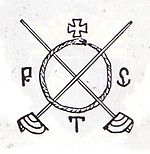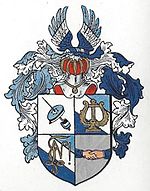Student associations in Russia
German, Russian , Estonian , Latvian and Polish student associations in Russia existed in St. Petersburg and Moscow .
St. Petersburg
In the 1840s, around 28,000 Germans lived among the 470,000 inhabitants of St. Petersburg. At that time the first student associations in Tsarist Russia were established there . They leaned on the German-Baltic student associations and adopted Dörpt's comment .
- Fraternitas Baltica I , 1837–1841 (German), dark blue-white-gold
- Ruthenia , 1837–1848 (Russian), orange-white-black, orange high lid with black St. George's cross
- Fraternitas Baltica II , 1842–1848 (German), dark blue-white-gold
-
Polonia , 1838–1846, (Polish), white-red-silver
With German business language and German comment, the Polonia was also open to Russians and other nationalities who felt drawn to the German cultural area. - Hippokratica , 1843–1851, “Free German Boys' Association”, black-silver-red
-
Nevania , 1847–1917 (German), light blue-white-dark blue, light blue lid
The association was founded on November 24, 1847 by six medical students at the Military Medical Academy . They did not want to join the Hippokratica because they saw more in boyhood than "drinking and fighting". Motto honor, Muse, brother sense! Nevania was in a cartel with the German Teutonia. She gave up the official name Corps in September 1862 for police reasons. Since 1909 she was in the cartel with the Dorpater and Riga corporations. The Corps Concordia Rigensis took over the tradition and archives of Nevania in 1969. -
Teutonia , 1854–1857 / 1861 (German), dark blue-orange-white
Since 1854, she was with Nevania in the Petersburg Chargierten-Convent (Ch! C!). In 1856 she took over her comment. In 1872 eight Teutons became honorary philists from Nevania. - Fraternitas Borealis , 1857–1861 II (German), green-white-red, green lid with three white linden leaves
- Germania , 1870–? (German), blue-white-red
- Tritonia , 1875–?, Dark blue-white-light green
- Rossia , 1883–? (Russian), white-light blue-red, dark blue lid
- EÜS Pohjala , 1884–1917 (Estonian), not colored
-
Fraternitas Petropoliensis , 1896 (Latvian) later - Fraternitas Petropolitana gold-violet-green, yellow cover
1922 to Riga, 1924 reactivated Fraternitas Metropolitana. Reactivated on December 18, 1989 in Riga. -
Neo-Ruthenia , 1907–1917 (Russian), black-white-orange, black cover with a white St. George's Cross
Since many students took part in the 1905 Russian Revolution , all universities were closed. Some went to Germany and reported on the German liaison system when they returned home. KG Kruschejow, who was in Heidelberg, founded the national Russian Neo-Ruthenia. From 1912 she was in the cartel with the Fraternitas Arctica in Riga. Most of the Neo-Ruthenians fell in World War I or perished in the October Revolution and the Civil War that followed . - Boreatica , 1902–1917 (Russian) later - Денница (Denniza).
-
Korporacja Akademicka Sarmatia , 1908–1915 (Polish), raspberry-red-silver-pale green, raspberry-red lid
1915 to Warsaw , reactivated there on May 28, 1993. -
Fraternitas Hyperborea , 1909–1918 (German), dark blue-silver-orange, dark blue lid with a silver star
Founded on November 23, 1909 in Saint Petersburg. Parts of the members constituted the Fraternitas Normannia, Free German Burschenschaft (dark red-silver-blue) on May 4, 1918. From September 1918 branch convent Fraternitas Thervingia in Dorpat, 1920–1938 Fraternitas Normannia. 1931–1934 another branch convent in Reval. Following the example of the original fraternity, the Nordic Brotherhood sought a democratic German student body Dorpat; Estonia, Livonia, Neobaltia and the Fraternitas Academica did not want to give up the claim to leadership of the hundred-year-old Chargiertenconvent. It was not until 1933 that a cartel came about between the Chargiertenconvent and the Fraternitas Normannia. October 5, 1918; again Fraternitas Normannia October 1921; Colors carmine-silver-dark blue; crimson hat; 2nd Convent in Reval April 6, 1931 to WS 1934/35, suspended SS 1938. - Aesthetica , 1910–? (Polish), pink-white-pink, purple lid
-
Rotalia , 1913 (Estonian), cornflower blue-black-light green, cornflower blue lid
1918 after Tartu (Dorpat). 1990 reactivated in Tartu and Tallinn.
Moscow
Before the First World War , Moscow also had a strong German colony , where the sons of entrepreneurs and traders studied at Lomonosov University . During the war, some connections from Dorpat and Riga moved to Moscow, where they remained until the October Revolution in 1917, and in some cases until 1918. Since the end of communism there have been numerous German-language color carriers again.
- Fraternitas Mosquensis , 1859–1863 (German), blue-red-gold
- Baltica , 1889–1890, "Landsmannschaft"
-
Fraternitas Moscoviensis , 1902, blue-silver-green, blue cover; from 1912 blue-green-gold
1919 to Riga, 1920 Fraternitas Lettica. Reactivated on May 12, 1989 in Riga. -
Concordia Moscoviensis , 1909–1914, white-red-green, white lid with green star.
The federation was founded on February 28, 1909 and ministerially confirmed on September 6, 1910. It was only allowed to accept students from the university (founded in 1765). Students from other universities found as Konkneipanten recording. Comment and timpani on clubs based on the Baltic model. - Fraternitas Arctica , moved to Moscow in 1915, today again in Riga.
-
AV Moscovia , since 2008, black-red-gold (cockade or tip)
German-speaking holiday group for colored members of all leagues and associations.
literature
- K. Schmidt: A Russian 50 years ago about student corporations in Petersburg . Monthly magazine of the Rudolstädter Senioren-Convents (Berlin), 36th year / No. July 7, 1930, pp. 134-135; Reprinted in Einst und Jetzt, yearbook of the Association for Corporate Student History Research, Vol. 43 (1998). Pp. 174-178.
- Walter Lange : The relations of the Nevania-St. Petersburg to the Fraternitas Baltica in Riga . Einst und Jetzt, Vol. 26 (1981), pp. 173-184
- Harald Seewann : Burschentum in St. Petersburg and Moscow. An overview of the corporations formerly founded in these cities . Einst und Jetzt, Vol. 43 (1998), pp. 157-178.
- Wilhelm O. Keller 1971 «Das Russische Burschentum» self-published, упоминается в книге "On the scale !: History of the hitting corporations in Switzerland: Contributions to Swiss academic life and foreign weapons students" Max Richter 3 Arma-Verlag, 1978.
- Завьялов Дмитрий Анатольевич. Студенческие научные общества Санкт-Петербургского университета в конце XIX - начале XX в. : дис. … Канд. ист. наук: 07.00.02 СПб., 2006 338 с. РГБ ОД, 61: 07-7 / 176.
Web links
- Baltic Philistine Association
- Fraternitas Arctica (Lat. WP)
- Bibliography on Baltic, Latvian and Russian corporations (Association for Corporate Student History Research)
Remarks
- ↑ Members of the Fraternitas Baltica I: P. Preiss, Bruhns, Budberg, van der Fliet, von Grothe, Fannenstiel, Lichtenstein.
- ↑ Members of the Ruthenia: Prince Lobanow-Rostowsky, Beklescheff, Mordwinoff, Bobrinsky, Kawelin, Philippow, J. Bjelow, Chomjakow . Permanent guests were Pushkin and Pirogov .
- ↑ Founders of the Fraternitas Baltica II: Fritz Höppener, Frederici, Schneider, Theodor Säfftgen, Paul Jordan, Koch
- ↑ Founders of Teutonia: Roderich Voss, Julius Kayser, Friedrich Jordan, Ernst Donat, Friedrich Linse, Edmund Schaefer, Leopold Blacher, Karl Blacher, Eduard Kayser, Heinrich Stürmer and Marpurg
- ↑ Teutonia's honorary philistine near Nevania: Roderich Voss, Julius Kayser, Friedrich Jordan, Julius Ferchmin (Frat. Mosquensis), Carl Hiekisch (Frat. Acad. Dorpatensis), Alexander Dobrinin, Boris von Semeka and Ernst Donat
- ↑ The Fraternitas Arctica has risen again after perestroika.
- ↑ The founders of the short-lived connection were E. Grüner, R. Bödrich, Mengden, Freytagh-Loringhoven, Stamm and others.
Individual evidence
- ↑ a b c H. Seewann (1998)
- ^ W. Lange: The relations of Nevania St-Petersburg to the Fraternitas Baltica in Riga . Einst und Jetzt , Vol. 26 (1981), pp. 173-184.
- ↑ Website of the Academic Association Moscovia ( Memento of the original from March 4, 2016 in the Internet Archive ) Info: The archive link was inserted automatically and has not yet been checked. Please check the original and archive link according to the instructions and then remove this notice. , accessed November 1, 2014




